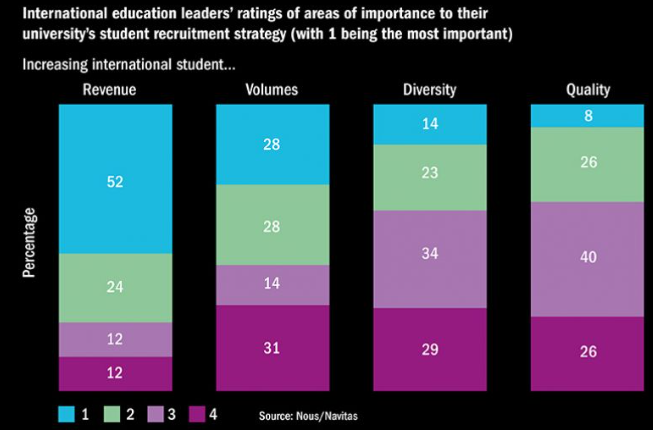A new poll of more than 100 international education leaders in Australia, Canada and the UK shows that universities are prioritising increasing overseas student recruitment and revenue over improving diversity and quality.
More than half said that the number one priority of their recruitment strategy was increasing revenue. More than a quarter ranked student volumes as their first concern, with less than one in seven nominating student diversity and one in 12 citing student quality:

The Albanese Government is certainly helping the universities out in this regard given it has explicitly targeted volume by:
- Allowing international students to work unlimited hours while studying in Australia; and
- Extended post-study work rights for an additional two years.
These reforms, alongside increasing the permanent migrant intake by 35,000, have effectively turned student visas into low-skilled work visas, which has sent student visa applications soaring. As noted explicitly by Abul Rizvi this week:
In 2022, Australia received 362,462 offshore student visa applications. This far exceeded the previous records set in 2018 of 278,691 and in 2019 of 276,183. In 2022, the number of student visa holders in Australia grew from 315,949 at end December 2021 to 456,970 at end December 2022; an increase of 141,021.
This was the single biggest annual increase in student visa holders in Australia ever. This will grow significantly further in 2023.
And despite a very strong labour market and a larger migration program providing opportunities for temporary graduates to secure permanent residence, the number of former students on temporary graduate visas increased in 2022 from 95,259 to 144,694 – an increase of almost 50,000.
The increase in offshore student visa applications is being driven by the granting of unlimited work rights – the student visa has essentially become a low skill guest worker visa…
Basically, Labor has turned international education into the very “ponzi scheme” that Labor backbencher Julian Hill warned about late last year:
“Uncapped work rights is being misused by agents in many parts of the world who are flogging our precious student visa as some kind of cheap, low rent work visa. No one should permit that to continue,” Mr Hill said…
“We know that the incentive of a permanent visa to Australia is like a golden ticket from Willy Wonka’s chocolate bar,” Mr Hill said.
“It’s too powerful an incentive that would drive and pervert behaviour by providers, and some students.”
Instead of operating a “ponzi scheme”, why not instead aim for a smaller intake of higher quality international students via:
- Raising entry standards (particularly English-language proficiency);
- Raising financial requirements needed to enter Australia; and
- Removing the explicit link between studying, work rights and permanent residency.
These reforms would raise student quality, would lift export revenues per student, would improve wages and conditions in the labour market, and would reduce enrolment numbers to sensible and sustainable levels, in turn improving quality and the experience for local students and reducing population pressures.
Sadly, the Albanese Government has taken the opposite approach because it knows that if work rights and permanent residency were scaled back, the numbers of students arriving would plunge, alongside Labor’s Big Australia agenda.
Instead, Labor has ushered a housing and inequality disaster by explicitly encouraging quantity of immigration over quality.

